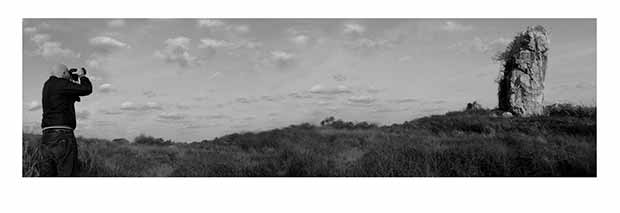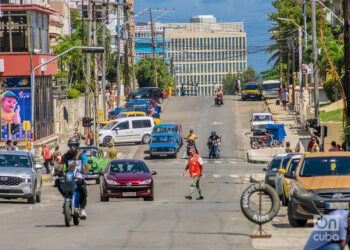In the end the coronary artery devours all possible limits. Tomas Sanchez knows that, that’s why he goes irreversibly deep into everything there is. He digs universal shapes; he digs and wonders about shadows and colors because time best defines us in solitude or in love. He digs and crumples canvases or the camera; he digs in the eyes, in the paradise of the eyes, in the injustice of the eyes, in the singularity, in the chaotic beauty of the eyes, in its contingency, its display, in the revelation of its solitude. That’s just a game of illusions but it tries to poke a personal shape of truth. I warn you, you should not be amazed by the fact that the plastic work by artist Tomas Sanchez (1948) moves around different landscapes knitted from the inside.
He returns to Cuba, after more than two decades without a personal exhibit in the island, with Notas al paso, a digital photographic sample in large scale, which takes over the halls of the Wilfredo Lam Contemporary Art Center in Havana. Right in front of us pieces are reborn, suggesting, inviting, questioning because the most transcendental occurs as spectators look at them,in sensibility, in emotive readings, in the endless caudal of interior landscapes that flow out of their frames and compositions. This time, sea and waves, land and rocks make up the visual creation of this artist that explores nature in the northern area of the country and in the coastal region of Costa Rica.
“Even though critics have placed Tomas Sanchez in the starting point of the Cuban hiperrealistic movement that had a boom in 1974, along with Rogelio López Marín and Flavio Garciandía, the truth is that his work doesn’t portray a naturalistic concern nor a cult to exact reproduction but rather a will to generate illusion”, says Spanish art critic Fernando Castro.
Tomas himself talks about the stages of his creative process and notes that his link with nature is based on meditation and similarly nature takes him to meditation: “The interior experience is that of uniting everything there is; the exterior experience is union in diversity. This makes me more sensitive to everything around me. I respect diversity and freedom of expression, in life and in the arts”, he explains.
Many times he has confessed he started a more “emotional” painting. Perhaps that’s the trigger that have led many critics to see a new conceptual dimension in his work within landscape painting, a school that already in the 20th century seemed to have decreased its creative heritage. But history began earlier, by his mother’s hand, when he learned to observe sunsets in detail in Cienfuegos, his home town. Those were his first impressions of the “natural” in his childlike sensitivity. With a work that isn’t exclusively landscape painting, Sanchez is considered one of the most influential painters of the 20th and 21st centuries.
His relation with photography emerged in Thelvia Marín and Gory’s study. Years after, with the boom of digital photography, he retook it though at first as amateur. Cuba exhibits his fifth photographic sample, a set of pieces that close an important chapter of his creative work, after 30 years of that Biennial in Havana, where he received one of the awards presented.
“Its architect, a metaphorical tropological subject, warns that metamorphosis towards that new mission in which reality is replaced by its respective representations; the same thing that happens in the copula where the satisfaction of desire murders the subtle writing of authentic eroticism. The gymnastics of the lens scans the landscape as phallic conquerors do with the desired body. The will to write emerges from that struggle of interests and perspectives…” notes critic and essayist Andres Isaac Santana when referring to Tomas’ work.
According to Santana: “He may have become one of the most frequent references, copied (almost traced to the verge of forgery) by many young artists that take him already as a classic. In the same way, his work becomes some sort of style that deliberately attempted to extinguish all its possibilities among many others, by getting close, then, joyfully to his own idea of classic.”
Photography continues gaining space in his life; also is painting, which refuses to abandon his workshop. Anyway, he is interesting in digging into the world that is huge, within oneself. He digs looking for beauty, harmony, synchronism and sensitivity, though there might be deep curtains that tinge the eye and deny the order of things. Nevertheless, he tries. Memory is a difficult landscape.










